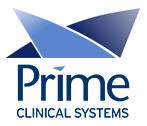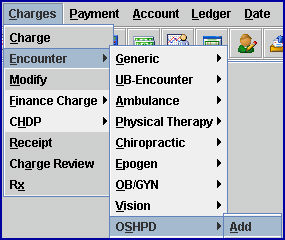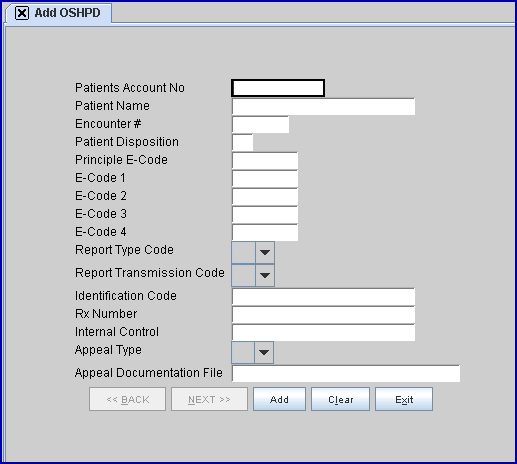
Intellect™
CHARGES MENU OPTIONS

OSHPD Encounter
This menu option is used to post additional reporting information needed to satisfy government regulations. The data is transmitted electronically.
To process the information from this screen, the encounter number should be attached to the normal billing for this patient. A separate insurance record for OSHPD should be created and used to submit all OSHPD data for the correct filing period via Billing --►Tele Com --►Submit Claim --►Group of Patients <Claim Type> = OSHPD.
See instructions to add encounter information to a patient’s account.
Updates:
Effective version 16.05.20
In prior versions, for the Internal Control Number (ICN) to be included in the Electronic Claims, the ICN had to be entered in the <Internal Control> field. Effective this version, Intellect now pulls the ICN number from the charge. This is handled by Intellect when auto-posting is used to post payments from the payers. This modification is NOT retroactive. Additionally, this ICN now also prints on the printer EOB from Intellect.
Effective version 14.07.01
When Intellect looks for a Referring Provider (a.k.a. ordering physician), Intellect first looks at the encounter screen for either <Ordering Provider> or <Supervising Provider> and, when either is blank, Intellect looks at the Utility --►Set Up --►Parameter <Referring> setting and pulls the referring provider based on the setting.
Effective Version 9.12.27
For clients who complete most of the Encounter screen fields with the same values for each patient, version 9.12.27 allows a 'default' record to be set up with the value to be carried over to all new Encounters.
To set up a default screen, go to Charges --►Encounter. Select the type of Encounter screen the office uses (the sample below is for Generic Encounter), then select Modify. At the <Patient Account No> field, enter 0 (zero). At the <Encounter #> field, enter 0 (zero).

Complete any field to default to all new Encounters entered.
Setting up the default encounter screen does NOT affect any encounters already entered.
1. To add encounter information to a patient’s account in Intellect, go to Charges --► Encounter --►OSHPD --►Add

The Add OSHPD screen displays:

This screen, like many in Intellect, has several optional fields. The graphics in this documentation may vary slightly from actual clinics. See the options on this screen and/or the documentation on adding/removing fields.
2. Patients Account No 
2.1 When not already displayed, type the patient’s account number.
2.2 Enter the account number, OR type up to 6 characters of the last name and press the [F2] key. To select the code from the list, either highlight the record and press the [Enter] key, OR double-click on the record.
3. Patients Name 
3.1 The patient’s name is displayed. This is a read-only field and may not be accessed.
3.2 The display is formatted Last, First.
4. Encounter # 
4.1 This number is assigned automatically when adding a new record.
4.2 This number is used to individually display this encounter.
5.1 Type the two-digit patient disposition code. If left blank, it defaults to '01' Routine Discharge.
Disposition of Patient Codes
01 Discharged to home or self care (routine discharge)
02 Discharged/transferred to a short term general hospital for inpatient care
03 Discharged/transferred to skilled nursing facility (SNF) with Medicare certification in anticipation of covered skilled care
04 Discharged/transferred to an intermediate care facility (ICF)
05 Discharged/transferred to another type of institution not defined elsewhere in this code list
06 Discharged/transferred to home under care of organized home health service organization in anticipation of covered skilled care
07 Left against medical advice or discontinued care
20 Expired
43 Discharged/transferred to a federal health care facility
50 Discharged home with hospice care
51 Discharged to a medical facility with hospice care
61 Discharged/transferred to a hospital-based Medicare approved swing bed
62 Discharged/transferred to an inpatient rehabilitation facility (IRF) including rehabilitation distinct part unit of a hospital
63 Discharged/transferred to a Medicare certified long term care hospital (LTCH)
64 Discharged/transferred to a nursing facility certified under Medicaid (Medi-Cal), but not certified under Medicare
65 Discharged/transferred to a psychiatric hospital or psychiatric distinct part unit of a hospital
66 Discharged/transferred to a Critical Access Hospital (CAH)
00 Other
6. Principal E-Code 
6.1 Type the code reported on the record for the first episode of care reportable to the OSHPD Office during which the injury, poisoning, and/or adverse effect was diagnosed and/or treated.
6.2 The principal E-code is defined as the external cause of injury or poisoning or adverse effects which describes the mechanism that resulted in the most severe injury, poisoning, or adverse effect. If sequencing the external cause of the most severe injury as the principal E-code is contradictory to the guidelines given in ICD-10, OSHPD reporting requirements take precedence.
6.3 External cause codes (E800-E999)
7.1 Enter an additional E-code to be reported, if necessary, to completely describe the mechanisms that contributed to, or the causal events surrounding, any injury, poisoning, or adverse effect.
8. E-Code 2 
8.1 Enter an additional E-code to be reported, if necessary, to completely describe the mechanisms that contributed to, or the causal events surrounding, any injury, poisoning, or adverse effect.
9. E-Code 3 
9.1 Enter an additional E-code to be reported, if necessary, to completely describe the mechanisms that contributed to, or the causal events surrounding, any injury, poisoning, or adverse effect.
10. E-Code 4 
10.1 Enter an additional E-code to be reported, if necessary, to completely describe the mechanisms that contributed to, or the causal events surrounding, any injury, poisoning, or adverse effect.
11.1 This field is used to designate a supplemental report type that will be forwarded separately. It works with the <Report Transmission Code> and <Identification Code> fields.
11.2 To view the list of codes with descriptions press the [F2] key. To view the list of only the codes either click on the arrow, OR press the → (right arrow) on the keyboard. To select, double-click on the correct code, OR use the ↑ (up) and ↓ (down) arrows to highlight the correct code, and then press the [Enter] key to select.

12.1 This field is used to designate the method of transmission.
12.2 To view the list of codes with descriptions press the [F2] key. To view the list of only the codes either click on the arrow, OR press the → (right arrow) on the keyboard. To select, double-click on the correct code, OR use the ↑ (up) and ↓ (down) arrows to highlight the correct code, and then press the [Enter] key to select.

12.3 This field works with the <Report Type Code> and <Identification Code> fields.
13.1 This is used in electronic claims submission.
13.2 Type the Attachment Control Number from the pre-printed MEDI-CAL CLAIM Attachment Control Form. The form must accompany the supporting documentation.
NOTE: When completing the encounter record: it is recommended to include the ATTACHMENT CONTROL NUMBER as part of the Encounter Description.
13.3 PCM users only. Effective version 14.07.01:
13.3.1 With the focus in this field, press the [F2] key twice to display a list of document files pulled from the Progress Notes in PCM (the list does NOT include files generated in Intellect or manually saved to the /home/staff/EB_ATTACHMENT folder).
13.3.2 To display only a certain type of file, enter the beginning letters of the file and then press [F2].
13.3.3 Click on the appropriate file to select it. Multiple files may be selected by holding down the [Ctrl] and [Shift] keys while clicking on the desired files. The file's Document Id displays.
13.4 This field works with the <Report Type Code> and <Report Transmission Code> fields.
14.1 The Claim Frequency Code is used only for electronic claims submission Loop 2300 CLM05 - 3, and indicates what type of claim it is. For example an original submission, corrected claim which is being resubmitted, a replacement claim, or a voided claim. The default is set to ‘1': Original Submission. Prior to adding this field on the Encounter screen the system submitted all claims with Claim Frequency Code 1.
14.2 To view the list of codes with descriptions press the [F2] key. To view the list of only the codes either click on the arrows, OR press the → (right arrow) on the keyboard. To select, double-click on the correct code, OR use the ↑ (up) and ↓ (down) arrows to highlight the correct code, and then press the [Enter] key to select.

14.3 When making an appeal for a Worker's Comp claim, in addition to this field, the <Internal Control>, <Appeal Type>, and <Appeal Documentation File> fields MUST be filled.
15.1 Enter the unique identification number assigned by the pharmacy or supplier to the prescription. It uses Loop 2410 REF02 with the Qualifier XZ.
15.2 A written prescription is required for all DME rental and purchases.
16.1 EDS assigns each claim an Internal Control Number (ICN) systematically when it is received electronically or by mail. Processing or returning the claim constitutes EDS’ final action on that claim. A resubmission of the same service is considered a new claim. Each claim sent to EDS is assigned an ICN automatically, which is used to track the claim. The ICN is made up of 13 digits in a specific format. The format of the ICN enables the determination of when the EDS actually received the claim.
16.2. This is used when rebilling a corrected claim to provide the insurance the original claim control number on a denied claim.
16.3 This number is included in the electronic transmission for all claims. It is a number assigned by the payer to identify a claim. The number is usually referred to as an Internal Control Number (ICN), Claim Control Number (CCN), or a Document Control Number (DCN). CLM, 2300 REF02 is the Loop and segment:
CLM*1.608.1.491.G*250***11:B:7*Y*A*Y*Y*P
REF*F8*20024E011000 ß
16.4 When making an appeal for a Worker's Comp claim, in addition to this field, the <Claim Frequency Code>, <Appeal Type>, and <Appeal Documentation File> fields MUST be filled.
17.1 This field is used to identify the level of the appeal, if needed.
17.2 Use the drop-down list and select the appropriate option:

17.3 When making an appeal for a Worker's Comp claim, in addition to this field, the <Claim Frequency Code>, <Internal Control>, and <Appeal Documentation File> fields MUST be filled.
18.1 If there is documentation that needs to be sent to the insurance company, enter the file name of the documentation.
18.2 Files with valid file names are sent directly to the insurance company.
18.3 Effective version 14.07.01:
Clients with Intellect only:
18.3.1 Create and save Appeal Document(s) files in the /home/staff/EB_ATTACHMENT folder. SBRs may also be saved as a .pdf to the /home/staff/EB_ATTACHMENT folder and attached as appeal documents.
18.3.2 Type the exact file name in this field. Note: This field is case-sensitive.
Clients with both Intellect and Patient Chart Manager (PCM) only:
18.3.3 With the focus in this field, press the [F2] key twice to display a list of document files pulled from the Progress Notes in PCM (the list does NOT include files generated in Intellect or manually saved to the /home/staff/EB_ATTACHMENT folder).
18.3.4 To display only a certain type of file, enter the beginning letters of the file and then press [F2].
18.3.5 Click on the appropriate file to select it. Multiple files may be selected by holding down the [Ctrl] and [Shift] keys while clicking on the desired files. The file's Document Id displays.
18.4 When making an appeal for a Worker's Comp claim, in addition to this field, the <Claim Frequency Code>, <Internal Control>, and <Appeal Type> fields MUST be filled.
19. When the information is completely entered, select one of these options:

19.1 Click to clear the screen and return the focus to <Patient Account No>, saving the new encounter.
19.2 Click [Clear] to display this message:

19.2.1 Click [Yes] to clear the screen and return the focus to the <Patient Account No> field, saving the new encounter.
19.2.2 Click [No] to clear the screen and return the focus to the <Patient Account No> field without saving.
19.3 Click [Exit] to display this message:

19.3.1 Click [Yes] to clear the screen and return the focus to the main Intellect screen, saving the new encounter.
19.3.2 Click [No] to clear the screen and return the focus to the main Intellect screen without saving.